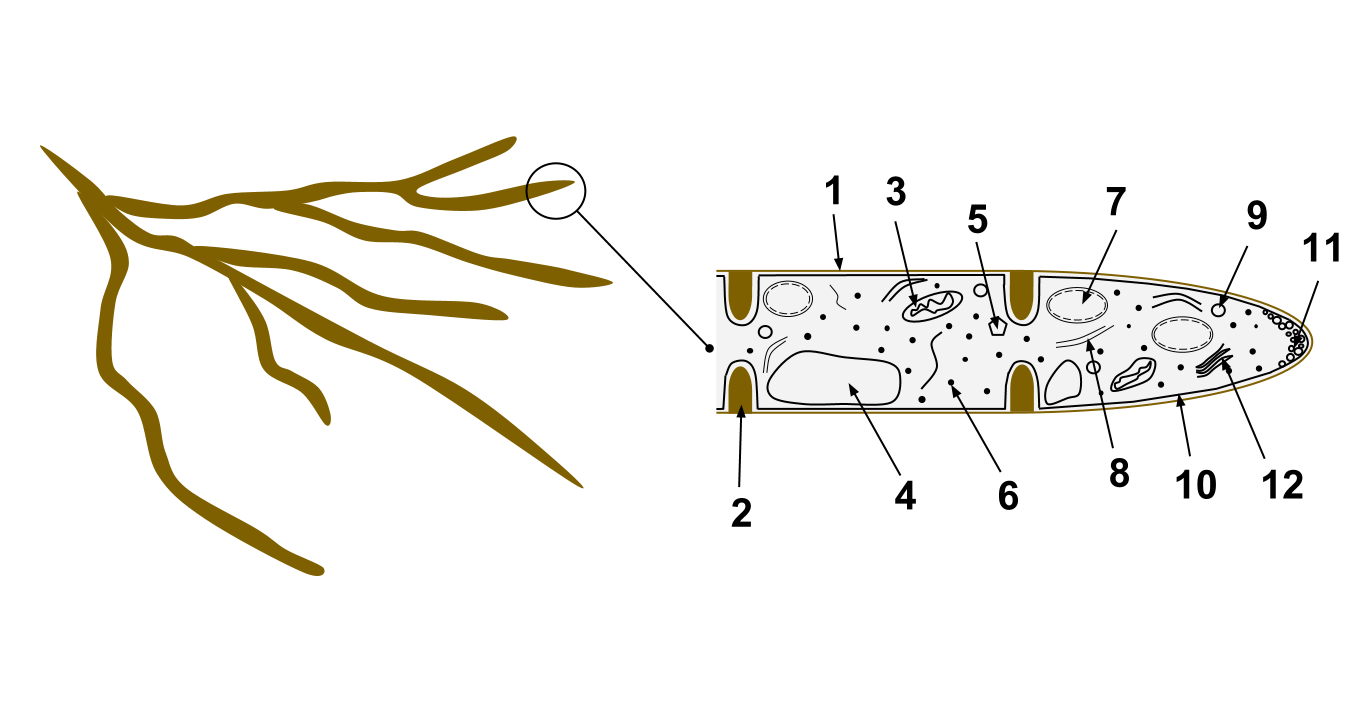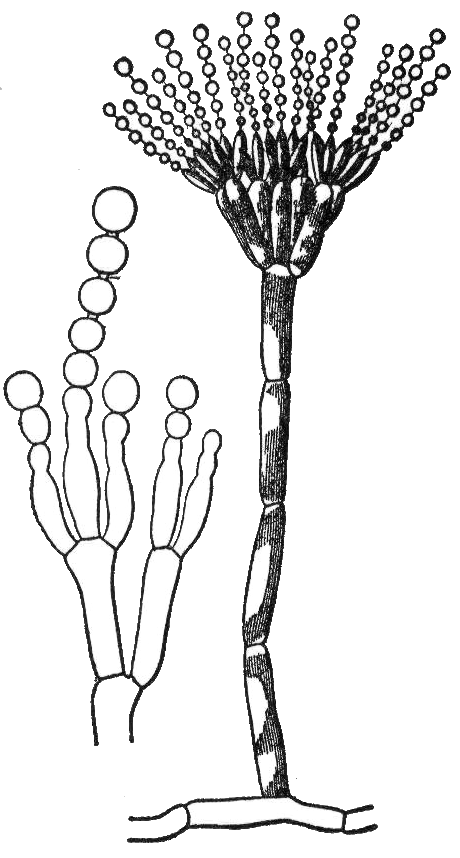|
Zygomycetes
Zygomycota, or zygote fungi, is a former division or phylum of the kingdom Fungi. The members are now part of two phyla: the Mucoromycota and Zoopagomycota. Approximately 1060 species are known. They are mostly terrestrial in habitat, living in soil or on decaying plant or animal material. Some are parasites of plants, insects, and small animals, while others form symbiotic relationships with plants. Zygomycete hyphae may be coenocytic, forming septa only where gametes are formed or to wall off dead hyphae. Zygomycota is no longer recognised as it was not believed to be truly monophyletic. Etymology The name ''Zygomycota'' refers to the zygosporangia characteristically formed by the members of this clade, in which resistant spherical spores are formed during sexual reproduction. ''Zygos'' is Greek for "joining" or "a yoke", referring to the fusion of two hyphal strands which produces these spores, and ''-mycota'' is a suffix referring to a division of fungi. Spores The ter ... [...More Info...] [...Related Items...] OR: [Wikipedia] [Google] [Baidu] |
Zoopagomycotina
The Zoopagomycotina are a subdivision (''incertae sedis'') of the fungal division Zygomycota '' sensu lato''. It contains 5 families and 20 genera.ygomycetes.orgurl=http://zygomycetes.org/index.php?id=8 Relationships among and within subphyla of Zygomycota are poorly understood, and their remains in question, so they are sometimes referred to by the informal name zygomycetes. Zoopagomycotina are microscopic and are typically obligate parasites of other zygomycete fungi and of microscopic soil ani ... [...More Info...] [...Related Items...] OR: [Wikipedia] [Google] [Baidu] |
Mucoromycota
Mucoromycota is a division within the kingdom fungi. They include a diverse group of various molds, including the common bread molds '' Mucor'' and '' Rhizopus''. It is a sister phylum to Dikarya. It consists of mainly mycorrhizal fungi, root endophytes, and plant decomposers; Glomeromycotina, Mortierellomycotina, and Mucoromycotina. Informally known as zygomycetes I, Mucoromycota includes Mucoromycotina, Mortierellomycotina, and Glomeromycotina. Mucoromycotina and Glomeromycotina can form mycorrhiza-like relationships with nonvascular plants. Mucoromycota contain multiple mycorrhizal lineages, root endophytes, and decomposers of plant-based carbon sources. Mucoromycotina species known as mycoparasites, or putative parasites of arthropods are like saprobes. When Mucoromycota infect animals, they are seen as opportunistic pathogens. Mucoromycotina are fast growing fungi and early colonizers of carbon rich substrates. Mortierellomycotina are common soil fungi that occur as ... [...More Info...] [...Related Items...] OR: [Wikipedia] [Google] [Baidu] |
Mucorales
The Mucorales is the largest and best studied order of zygomycete fungi. Members of this order are sometimes called pin molds. The term mucormycosis is now preferred for infections caused by molds belonging to the order Mucorales. Systematics The order includes: 11 families, 56 genera, and approximately 300 species. Mucoralean classification has traditionally been based on morphological, developmental, and ecological characteristics. Recently, molecular data has revealed, that some aspects of traditional classification are quite artificial. For example, the Mucoraceae is believed to be polyphyletic, as are the Thamnidiaceae, Chaetocladiaceae and Radiomycetaceae. Some of the genera, (including ''Mucor'', ''Absidia'' and '' Backusella'') appear to be polyphyletic. Today, the traditional system is still largely in use, as further studies are needed to reconcile morphological and molecular concepts of families and genera. Families The order consists of the following familie ... [...More Info...] [...Related Items...] OR: [Wikipedia] [Google] [Baidu] |
Mortierellales
Mortierellales is a fungal order, within the phylum of Zygomycota and the monotypic, division Mortierellomycota. It contains only 1 known family Family (from la, familia) is a group of people related either by consanguinity (by recognized birth) or affinity (by marriage or other relationship). The purpose of the family is to maintain the well-being of its members and of society. Idea ..., Mortierellaceae , and 6 genera and around 129 species. Genera * '' Aquamortierella'' - 1 sp. * '' Dissophora'' - 3 sp. * '' Gamsiella'' - 1 sp. * '' Lobosporangium'' - 1 sp. * '' Modicella'' - 3 sp. * '' Mortierella'' - 120 sp. See also * Mortierella References External links * https://www.uniprot.org/taxonomy/214503 Zygomycota Fungus orders {{Zygomycota-stub ... [...More Info...] [...Related Items...] OR: [Wikipedia] [Google] [Baidu] |
Hyphae
A hypha (; ) is a long, branching, filamentous structure of a fungus, oomycete, or actinobacterium. In most fungi, hyphae are the main mode of vegetative growth, and are collectively called a mycelium. Structure A hypha consists of one or more cells surrounded by a tubular cell wall. In most fungi, hyphae are divided into cells by internal cross-walls called "septa" (singular septum). Septa are usually perforated by pores large enough for ribosomes, mitochondria, and sometimes nuclei to flow between cells. The major structural polymer in fungal cell walls is typically chitin, in contrast to plants and oomycetes that have cellulosic cell walls. Some fungi have aseptate hyphae, meaning their hyphae are not partitioned by septa. Hyphae have an average diameter of 4–6 µm. Growth Hyphae grow at their tips. During tip growth, cell walls are extended by the external assembly and polymerization of cell wall components, and the internal production of new cell membrane. Th ... [...More Info...] [...Related Items...] OR: [Wikipedia] [Google] [Baidu] |
Mucoromycotina
Mucoromycotina is a subphylum of uncertain placement in Fungi. It was considered part of the phylum Zygomycota, but recent phylogenetic studies have shown that it was polyphyletic and thus split into several groups, it is now thought to be a paraphyletic grouping. Mucoromycotina is currently composed of 3 orders, 61 genera, and 325 species. Some common characteristics seen throughout the species include: development of coenocytic mycelium, saprotrophic lifestyles, and filamentous. History Zygomycete fungi were originally only ascribed to the phylum Zygomycota. Such classifications were based on physiological characteristics with little genetic support. A genetic study of Zygomycete fungi performed in 2016 showed that further classification of the group was possible, thus splitting it into Zoopagomycota, Entomophthoromycota, Kickxellomycotina, and Mucoromycotina. The study put these groups as being sister to Dikarya, but without further research, their exact locations in Fungi ... [...More Info...] [...Related Items...] OR: [Wikipedia] [Google] [Baidu] |
Hypha
A hypha (; ) is a long, branching, filamentous structure of a fungus, oomycete, or actinobacterium. In most fungi, hyphae are the main mode of vegetative growth, and are collectively called a mycelium. Structure A hypha consists of one or more cells surrounded by a tubular cell wall. In most fungi, hyphae are divided into cells by internal cross-walls called "septa" (singular septum). Septa are usually perforated by pores large enough for ribosomes, mitochondria, and sometimes nuclei to flow between cells. The major structural polymer in fungal cell walls is typically chitin, in contrast to plants and oomycetes that have cellulosic cell walls. Some fungi have aseptate hyphae, meaning their hyphae are not partitioned by septa. Hyphae have an average diameter of 4–6 µm. Growth Hyphae grow at their tips. During tip growth, cell walls are extended by the external assembly and polymerization of cell wall components, and the internal production of new cell membran ... [...More Info...] [...Related Items...] OR: [Wikipedia] [Google] [Baidu] |
Zoopagales
The Zoopagales is an order (biology), order of fungi in the subdivision Zoopagomycotina. Most species are parasitism, parasites or predators of microscopic animals such as amoebae. They also prey on rotifers. The order contains 5 family (biology), families, 22 genera, and 190 species. References External links Zoopagales at Zygomycetes.org Zygomycota Fungus orders {{zygomycota-stub ... [...More Info...] [...Related Items...] OR: [Wikipedia] [Google] [Baidu] |
Entomophthorales
The Entomophthorales are an order of fungi that were previously classified in the class Zygomycetes. A new subdivision, Entomophthoromycotina, has recently been circumscribed for them. Most species of the Entomophthorales are pathogens of insects. A few attack nematodes, mites, and tardigrades, and some (particularly species of the genus ''Conidiobolus'') are free-living saprotrophs. The name Entomophthorales is derived from the Ancient Greek for insect destroyer ('' entomo-'' = referring to insects, and '' phthor'' = "destruction"). Highlighted species * '' Basidiobolus ranarum'', a commensal fungus of frogs and a mammal pathogen * '' Conidiobolus coronatus'', a saprotrophic fungus of leaf litter and a mammal pathogen * ''Entomophaga maimaiga'', a biocontrol agent of spongy moths * ''Entomophthora muscae'', a pathogen of houseflies * ''Massospora'' spp., pathogens of periodical cicadas * ''Pandora'', including ''Pandora neoaphidis'', an obligate pathogen of aphids Biol ... [...More Info...] [...Related Items...] OR: [Wikipedia] [Google] [Baidu] |
Phycomyces
''Phycomyces'' is a genus of fungus in the Zygomycota phylum. They are known for their strong phototropism response and helical growth of the sporangium. The best studied species is '' Phycomyces blakesleeanus''. Asexual reproduction ''Phycomyces'' can reproduce via extension of mycelia, or by production of spores either asexually or sexually. The asexual cycle includes the formation of spore containing sporangia borne on the top of sporangiophores that may extend 10 to 15 cm above the surface of the fungal colony from which they emerged. The long filamentous sporangiophores respond to divergent environmental signals including light, gravity, wind, chemicals and adjacent objects. The sporangia contain vegetative spores with one to six haploid nuclei. These spores when dispersed can establish new colonies. Sexual reproduction ''Phycomyces'' have two mating types that are indistinguishable morphologically. The sexual cycle is thought to occur by the following steps. Two ... [...More Info...] [...Related Items...] OR: [Wikipedia] [Google] [Baidu] |
Monophyletic
In cladistics for a group of organisms, monophyly is the condition of being a clade—that is, a group of taxa composed only of a common ancestor (or more precisely an ancestral population) and all of its lineal descendants. Monophyletic groups are typically characterised by shared derived characteristics ( synapomorphies), which distinguish organisms in the clade from other organisms. An equivalent term is holophyly. The word "mono-phyly" means "one-tribe" in Greek. Monophyly is contrasted with paraphyly and polyphyly as shown in the second diagram. A ''paraphyletic group'' consists of all of the descendants of a common ancestor minus one or more monophyletic groups. A '' polyphyletic group'' is characterized by convergent features or habits of scientific interest (for example, night-active primates, fruit trees, aquatic insects). The features by which a polyphyletic group is differentiated from others are not inherited from a common ancestor. These definitions have t ... [...More Info...] [...Related Items...] OR: [Wikipedia] [Google] [Baidu] |




